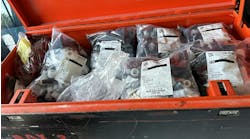Latest from Plumbing
Sponsored
By Steve Manis
An appealing detour in a long career as a plumber and union contractor came to me in 2004 when I joined Lubrizol Advanced Materials, the inventor of CPVC resin and the compound that goes into what is known more familiarly as Corzan Piping Systems.
I had used this product successfully in my work and if there was one thing I appreciated about it, it was that Lubrizol really stood by the manufacturing partners that extrude the compound into pipe or mold it into fittings, and the tradespeople who worked with it in their projects. To my mind, having that support system could be a point of pride for any plumber and contracting professional who sees their work as a skilled craft and wants to use quality materials. I was looking forward, as a regional product specialist, to bringing plumbers and contractors under the tent.
Now whether you’re a new plumber or an experienced pipe fitter with decades of experience welding metal pipes, your goal is to have a piping installation that is dependable, trouble-free and as easy as possible. And that is my goal as well. Because I stand with my customers as a reliable partner, I offer installation, field support and troubleshooting guidance as a standard practice. My starting point every day is asking: who can I make more confident today working with CPVC by giving them the tools to achieve an easy, lasting installation in record time with no rework?
It starts with mastery of the joining methods. Whether Corzan CPVC is prefabricated or fabricated onsite, installers have considerable flexibility in working with this lightweight material and a few handheld tools. It is so versatile it can be installed by just one or two people using either chemical (solvent welding) or mechanical joining methods, even in small or elevated workspaces. The decision will depend on pipe size and the installation considerations of the particular job.
Solvent welding involves a safe two-step process and easy cutting, but all too often, I find that I must first debunk the common misconception that “anyone can glue pipes together.” This statement is wrong for two reasons. One, solvent welding isn’t gluing; it is a chemical process. Secondly, while it is simple to install Corzan CPVC pipes and fittings, there are steps that need to be followed for the correct installation. When joined properly with solvent cement, Corzan CPVC pipe segments fuse chemically, and the back third of the socket is where 85 percent of the strength of the joint will be. Now that’s confidence!
Mechanical joining involves no cure times at all, which facilitates prefabrication. It is also ideal for alterations or repairs especially in larger facilities, as drying time is eliminated and system shutdown time is dramatically reduced. Depending on the application, installers can either use a cut-groove tool to groove the existing pipe and apply a mechanical coupling to complete the joint, or install a pre-grooved pipe and then apply the mechanical coupling. This option was the result of a years-long process intended to respond to customers’ requests for a portable, fast installation method that reduces system downtime without sacrificing long-term performance of the pipe and joints.
Furthermore, if the need arises to integrate CPVC pipe into existing systems of copper, stainless steel, carbon steel or galvanized steel, the same installation basics apply. Depending on the pipe size, several different joining technologies are available for mixed-material integrations, including NPT threaded fittings, flange to flange connections and mechanical couplings. Unlike some other plastics that can suffer degradation from proximity to copper ions, Corzan CPVC’s chlorinated structure offers inherently good resistance to oxidizers, which is crucial to know for water distribution system projects.
And speaking of compatibility, peak performance hinges on assuring that ancillary plumbing products like thread sealants, firestopping materials and pipe insulation are chemically compatible with CPVC. One of the tools we offer industry professionals to avoid mismatches and completely preventable issues later is our FBCTM System Compatible program. Qualifying product manufacturers all will have submitted their products for testing to a third-party lab, they may not alter the tested formulation in the future, and their facility will be audited annually by that same lab. These products are then marked with the FBC logo. There is no other program like this in the industry, and I take pride in providing this level of transparency to contractors.
Another point I continue to bring awareness to in the field, as it relates to oxidizers, is the important role CPVC plays in keeping drinking water clean and fighting the growth of biofilm, the proliferation of which can lead to outbreaks of Legionella. Corzan CPVC’s smooth, nonporous internal pipe surface can withstand ASHRAE 188 Guideline decontamination procedures requiring very high temperatures and/or highly chlorinated water as well as inhibiting the growth of bacteria and biofilm. This becomes even more pertinent when you know that changing local water treatment chemistries happen without warning and can have unforeseen effects on piping systems down the road.
With 15 years as a consultant under my belt, I can say that it is gratifying to help the skilled tradesperson avoid the simple oversights that can cause huge headaches down the road for facility managers and for plumbers who get called back to examine what went wrong with an installation. By working alongside contractors during the install, I can provide the support they need to make sure the job gets done quickly and accurately – the kind of knowledge that you will take with you to countless job sites in the future.
Steve is a licensed master plumber with more than 30 years of experience in the plumbing industry. He is a former mechanical contractor who installed piping systems for many years in commercial applications. Steve owned a plumbing business for more than 10 years and served as the director of plumbing for the third largest mechanical contractor in the United States. He holds master’s licenses in three Florida counties as well as a journeyman’s license. Steve is a UA Member and Local 719 Plumbers & Pipefitters member for 38 years.


